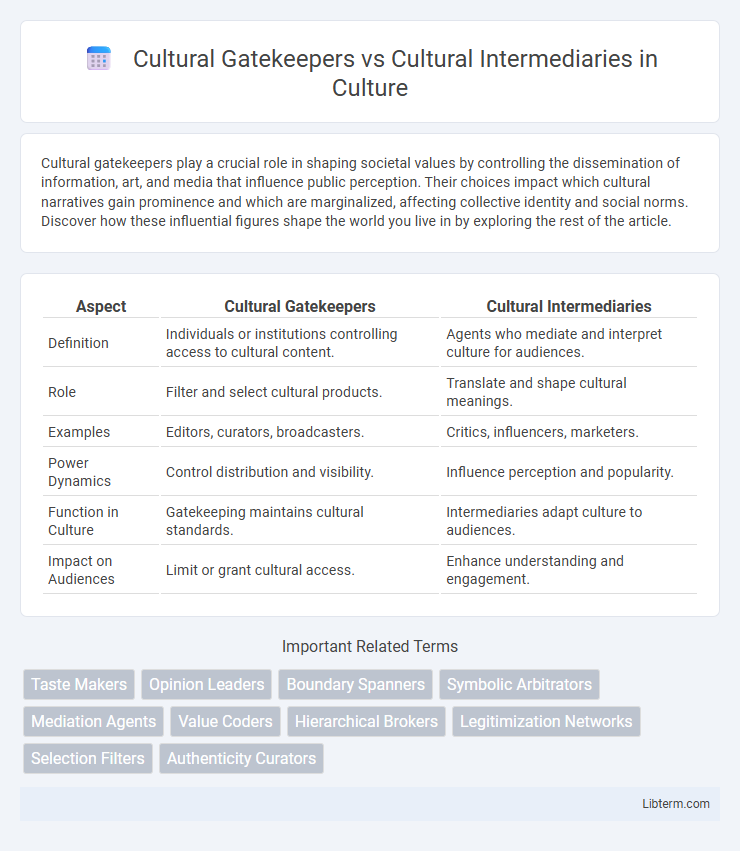Cultural gatekeepers play a crucial role in shaping societal values by controlling the dissemination of information, art, and media that influence public perception. Their choices impact which cultural narratives gain prominence and which are marginalized, affecting collective identity and social norms. Discover how these influential figures shape the world you live in by exploring the rest of the article.
Table of Comparison
| Aspect | Cultural Gatekeepers | Cultural Intermediaries |
|---|---|---|
| Definition | Individuals or institutions controlling access to cultural content. | Agents who mediate and interpret culture for audiences. |
| Role | Filter and select cultural products. | Translate and shape cultural meanings. |
| Examples | Editors, curators, broadcasters. | Critics, influencers, marketers. |
| Power Dynamics | Control distribution and visibility. | Influence perception and popularity. |
| Function in Culture | Gatekeeping maintains cultural standards. | Intermediaries adapt culture to audiences. |
| Impact on Audiences | Limit or grant cultural access. | Enhance understanding and engagement. |
Introduction to Cultural Gatekeepers and Cultural Intermediaries
Cultural gatekeepers are influential individuals or organizations who control access to cultural products and determine which art, media, or trends reach the public, shaping cultural consumption and societal values. Cultural intermediaries act as mediators between producers and consumers by interpreting, promoting, and circulating cultural content, thus influencing taste and market dynamics. Both roles are pivotal in the cultural economy, affecting how cultural meanings are constructed and disseminated across different audiences.
Defining Cultural Gatekeepers: Roles and Responsibilities
Cultural gatekeepers play a pivotal role in shaping which cultural products and ideas gain prominence by controlling access, interpretation, and distribution within media, arts, and entertainment industries. Their responsibilities include selecting, endorsing, and filtering content to align with societal norms, market trends, or institutional standards, directly influencing public perception and consumption patterns. These gatekeepers often consist of editors, critics, curators, and producers who possess authoritative knowledge and power to mediate cultural value and significance before reaching broader audiences.
Understanding Cultural Intermediaries: Functions and Influence
Cultural intermediaries actively shape consumer perceptions by mediating cultural products through curation, interpretation, and promotion within industries such as fashion, media, and art. Their influence extends to filtering cultural content, guiding trends, and facilitating the exchange between producers and audiences, thereby impacting consumption patterns and cultural value. Unlike gatekeepers who control access, intermediaries serve as brokers of meaning, enhancing cultural significance through strategic communication and symbolic capital.
Historical Evolution of Gatekeepers and Intermediaries
Cultural gatekeepers have historically controlled access to cultural products and shaped public taste through exclusive institutions like publishing houses, galleries, and broadcasting companies. Over time, the rise of digital platforms and social media has expanded the role of cultural intermediaries, who now facilitate cultural exchange by connecting creators directly with audiences, thus democratizing influence. This evolution reflects a shift from centralized, authoritative gatekeeping to a more decentralized, participatory mediation of culture.
Key Differences Between Gatekeepers and Intermediaries
Cultural gatekeepers control access to cultural content by deciding which ideas, products, or messages reach the public, often shaping public perception and trends. Cultural intermediaries, in contrast, facilitate communication and engagement between creators and audiences, helping interpret, mediate, and enhance cultural experiences without restricting access. The key difference lies in gatekeepers' authoritative filtering role versus intermediaries' collaborative and connective function in the cultural ecosystem.
The Impact of Digital Media on Cultural Mediation
Digital media has transformed the roles of cultural gatekeepers and cultural intermediaries by democratizing access to cultural content and enabling wider audience engagement. Cultural gatekeepers, traditionally controlling access to cultural products, now share influence with intermediaries who utilize digital platforms to curate, promote, and shape cultural consumption. This shift enhances cultural mediation through real-time feedback, diversified voices, and algorithm-driven content distribution, fundamentally altering power dynamics within cultural industries.
Examples of Gatekeepers in Various Cultural Sectors
Cultural gatekeepers exert control over access to cultural content by deciding which artists, works, or ideas gain exposure across sectors such as music, film, and literature, exemplified by record label executives, film festival selectors, and literary agents. In the fashion industry, editors and buyers act as gatekeepers by determining trends and which designers reach broader markets. Museum curators and gallery owners function as gatekeepers in the visual arts, influencing public access to art through exhibition choices, shaping cultural narratives and public taste.
Examples of Intermediaries Shaping Cultural Trends
Cultural intermediaries like fashion editors, social media influencers, and music producers play a crucial role in shaping cultural trends by selecting and promoting specific styles, artists, and products to wider audiences. For example, Vogue editors curate seasonal fashion collections that steer industry standards, while influencers on platforms like Instagram amplify emerging aesthetics through curated content and endorsements. These intermediaries mediate between creators and consumers, influencing taste formation and market demand across various cultural domains.
The Changing Power Dynamics in Cultural Production
Cultural gatekeepers traditionally controlled access to cultural production by determining which voices and works reached public audiences, maintaining centralized authority in media, publishing, and art industries. In contrast, cultural intermediaries now facilitate the diffusion and interpretation of culture through digital platforms, influencing trends and consumer preferences while democratizing access and participation. The shift in power dynamics reflects a move from exclusive control by gatekeepers to a more decentralized and participatory cultural landscape driven by social media influencers, content curators, and algorithmic recommendation systems.
Future Trends: Collaboration or Competition?
Future trends in the relationship between cultural gatekeepers and cultural intermediaries indicate a growing emphasis on collaborative models that leverage digital platforms and data analytics to enhance cultural dissemination and audience engagement. Technological advancements enable cultural intermediaries to democratize access and diversify cultural consumption, challenging traditional gatekeeping roles while simultaneously opening opportunities for partnerships that blend curatorial expertise with market responsiveness. The evolving landscape suggests a hybrid dynamic, where competition drives innovation and collaboration fosters inclusivity and adaptability within cultural ecosystems.
Cultural Gatekeepers Infographic

 libterm.com
libterm.com